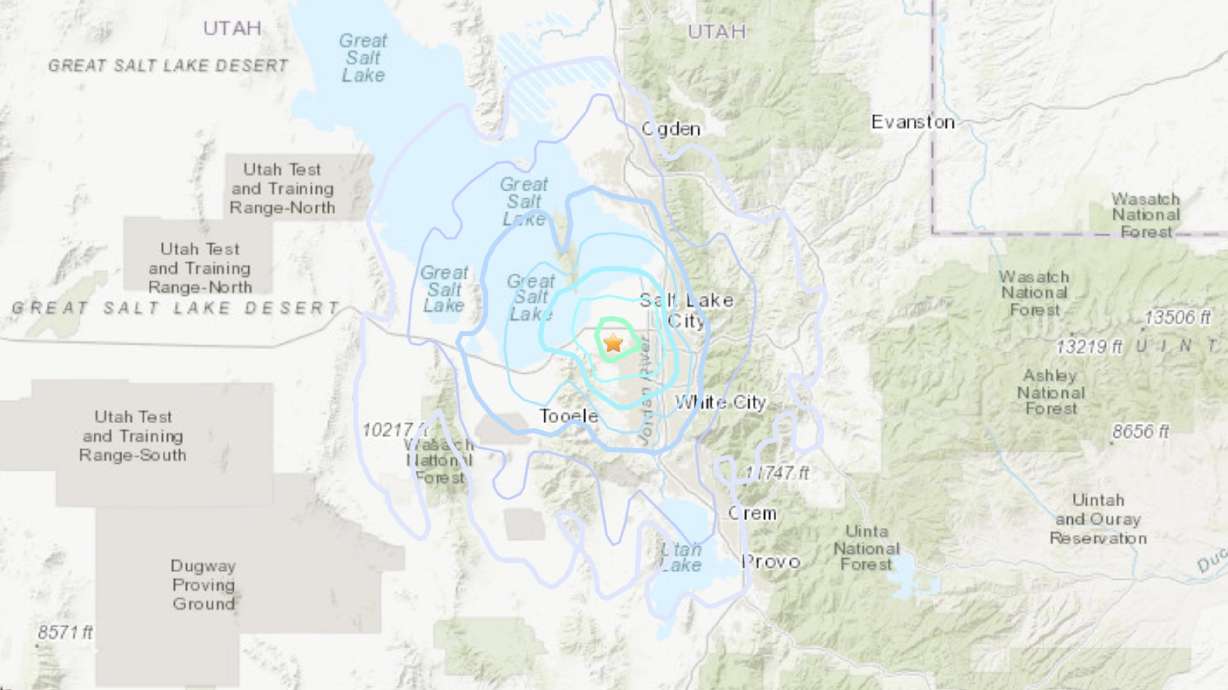Estimated read time: 3-4 minutes
This archived news story is available only for your personal, non-commercial use. Information in the story may be outdated or superseded by additional information. Reading or replaying the story in its archived form does not constitute a republication of the story.
SALT LAKE CITY — Another aftershock hit the Wasatch Front as a series of earthquakes continues following a magnitude 5.7 initial quake last month.
The aftershock struck about 7:40 a.m. Thursday morning northeast of Magna. The U.S. Geological Survey reported the initial magnitude of the aftershock at 4.2.
Most recently, a magnitude 4.17 aftershock shook Salt Lake, Davis and Tooele counties Tuesday evening after the initial magnitude 5.7 quake in the sequence hit near Magna on March 18.
Shakemap of this mornings M4.2 aftershock. pic.twitter.com/wlg3jC02JO
— UUSS (@UUSSquake) April 16, 2020
The aftershock Thursday was part of the sequence stemming from that original March 18 quake, according to the University of Utah Seismograph Stations. There is a "wide range" of what is considered normal for earthquakes, but the Magna sequence is being considered normal, the seismograph stations tweeted.
Earthquake experts said Tuesday's aftershock was likely to produce its own round of subsequent aftershocks.
"Feeling more earthquakes in the next week or so would not be unexpected," Jamie Farrell, a professor of seismology at the University of Utah, said Wednesday.
The earthquakes this week are still part of the Magna sequence. A lot of you are wondering if this is normal. There is a wide range of what is considered normal and the Magna sequence is within that range. Sometimes earthquakes barely have any aftershocks, and sometimes
— UUSS (@UUSSquake) April 16, 2020
(1/2)
Sometimes earthquakes can have very few or no aftershocks, but some have more than average, the seismograph stations added.
"This feels abnormal to us because this is the first time in most of our lives that we’ve lived near an earthquake sequence like this," the seismograph station tweeted. "But for the earth, this is business as usual."
The Great Utah ShakeOut, an annual earthquake safety drill, took place at 10:15 a.m. Thursday. During the drill, Utahns are encouraged to prepare for a real earthquake and seek shelter in their homes so they will know what to do in the event of a real event.
If organizations couldn't participate in the drill Thursday, they are encouraged to schedule their own ShakeOut at a later date. All drills completed in the 2020 calendar year will count towards the final tally at shakeout.org/utah, Utah Division of Emergency Management spokesman Joe Dougherty said during a press brief Thursday afternoon.
"We are inviting everyone across the state to be very creative with how you will be prepared for earthquakes today," Dougherty said.
Thursday morning, the Emergency Management division added that even though having two 4.2 magnitude quakes in the past few days is scary, everyone in Utah will be "earthquake pros" after this.
People are advised to take precautions, such as strapping heavy furniture and water heaters to the walls, so they don't fall over in the event of a larger quake, the agency said.
People should also make sure there aren't any heavy objects that could fall on beds during an overnight earthquake. A common cause of earthquake injuries is objects falling over onto people, the agency said.
Hey Utah, we know it seems strange to have two M4.2 aftershocks less than a month after the Magna quake.
— Utah Division of Emergency Management (Utah DEM) (@UtahEmergency) April 16, 2020
It seems scary because this is a new experience. You are all going to be earthquake pros after this.
Please share information from verified sources, like @UUSSquake.
1/https://t.co/OaMFPYLHxT
"The shakeout every year is a reminder to drop, cover and hold on to something sturdy, if you can," Dougherty said. "If you are in bed, stay there — provided you don’t have heavy shelving or a picture frame next to your bed."
“Many people during an earthquake are getting up and running to another location," Dougherty added. "Really, the best thing to do is make sure you stay in place. An earthquake can very easily drop you to the ground."
Click here to see a map of the latest earthquakes if you are on a mobile device.
Contributing: Sean Walker, KSL.com
Latest Earthquakes









